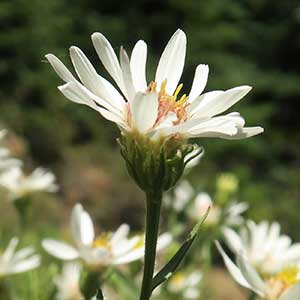Eucephalus tomentellus
Eucephalus paucicapitatus
brickellbush aster, hairy rayless aster, rayless aster
Olympic mountain-aster
erect, woolly or cottony.
ascending to erect, pilose or glandular-pubescent.
mid and distal blades lanceolate to elliptic, 2.5–6 cm × 7–20 mm, abaxial faces glabrous or glabrate, adaxial ± densely woolly to cottony.
mid and distal blades elliptic to elliptic-oblong, 2–4 cm × 4–13 mm, sparsely scabrous to stipitate-glandular abaxially, moderately stipitate-glandular adaxially.
pubescent.
stipitate-glandular.
turbinate, 7–10 mm.
turbinate-obconic, 7–9 mm.
in 4–6 series (often reddish at margins and apices), linear-oblong to ovate (strongly unequal), apices acute, abaxial faces tomentose to stipitate-glandular.
in 2–3 series (whitish), lance-linear (unequal), apices acute, abaxial faces stipitate-glandular.
3–40 in racemiform to paniculiform arrays.
usually 2–4 in racemiform to corymbiform arrays, somtimes borne singly.
glabrous or pilose;
pappus bristles in 2 series, ± barbellate.
obconic, pilose;
pappus bristles in 2 series, ± barbellate.
(0–)1–3(–6), violet-purple.
7–13(–21), white.
Eucephalus tomentellus
Eucephalus paucicapitatus
Eucephalus tomentellus grows in the Siskiyou Mountains of southwestern Oregon and northern California. It may intergrade with E. breweri and E. glabratus.
(Discussion copyrighted by Flora of North America; reprinted with permission.)
Eucephalus paucicapitatus is found on Vancouver Island, where it is very uncommon, and the Olympic Peninsula. It is closely related to E. gormanii.
(Discussion copyrighted by Flora of North America; reprinted with permission.)


